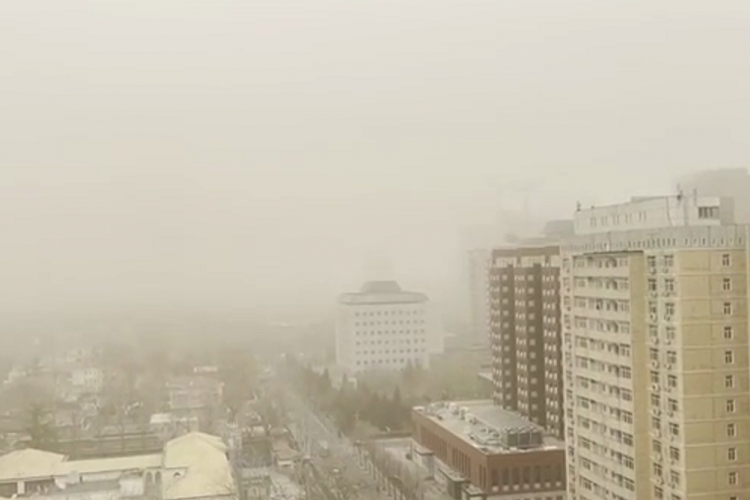Make Your Own DIY Air Filter for RMB 166
After staying in Beijing for nearly four years, I've learned to look for good bargains, so when I came across this do-it-yourself purifier post I could feel my sense of cheapness being called upon (despite the fact that the picture looks like a broken air conditioning unit).
The post on Tumblr by particlecounting, who just started blogging about a week ago, claims that you can make an effective indoor air purifier simply by taking a flat front motor run fan and strapping a HEPA filter (purchasable from Taobao for RMB 58) for a total of just RMB 166 (as opposed to the RMB 11,000 or so you'd pay for a high-end filter).
Related stories :
Comments
New comments are displayed first.Comments
![]() tomuw
Submitted by Guest on Tue, 10/01/2013 - 11:24 Permalink
tomuw
Submitted by Guest on Tue, 10/01/2013 - 11:24 Permalink
Re: Make Your Own DIY Air Filter for RMB 166
This is Thomas, the guy behind the DIY filter site.
And that's an excellent question! Does it work? I'm a believer in open data (and a nerd), so I've done many tests of the filter with a particle counter. You can see the data:
1. You can see a video of a test of the air coming out of the DIY filter here:
http://particlecounting.tumblr.com/post/55491154130/heres-test-1-is-the-air-thats-coming-out-of-the
2. I've done tests of ambient room air before and after turning the DIY filter on. You can see my data here:
http://particlecounting.tumblr.com/post/55665836265/purifier-tests
and here:
http://particlecounting.tumblr.com/post/55947941919/diy-compared-to-expensive-filters
3. And you can come to our workshops and test the DIY filters live on the spot with the particle counter.
http://smartairfilters.com/#workshops
As far as the seal goes, ours get a pretty good seal around the filter. For an improved seal, you can try using the more flexible pre-filter that comes with some filters. Perhaps your HEPA was different from the ones we use? Nowadays, I've been using velcro straps, which gets a tighter seal. Pictures here:
http://smartairfilters.com/#steps
Finally, this is a bit of a philosophical point, but how much the seal matters depends on whether you're (1) sending out air from a very dirty source into a clean room, as in a vacuum cleaner or (2) pushing air that's already in your room through a filter. In case 1, the seal is very important. In the second case, the seal is important, but a less-than-100% seal does not render it "useless," as you suggest. All you need is for some air to be going through the filter for it to be removing particulates from the air. But you don't have to take my word for it. Doctors at the University of Michigan have tests with a similar set up, and you can see their seal is not perfect:
http://particlecounting.tumblr.com/post/56577062878/independent-confirmation-ive-always-suspected
Thomas Talhelm
http://particlecounting.tumblr.com/
![]() GT
Submitted by Guest on Tue, 10/01/2013 - 11:21 Permalink
GT
Submitted by Guest on Tue, 10/01/2013 - 11:21 Permalink
Re: Make Your Own DIY Air Filter for RMB 166
That's just not true. It works! Thomas collected data with a particle counter from across the room; it's all over his blog. Please don't say it doesn't work if you don't have a particle counter.
![]() admin
Submitted by Guest on Thu, 09/26/2013 - 12:57 Permalink
admin
Submitted by Guest on Thu, 09/26/2013 - 12:57 Permalink
Re: Make Your Own DIY Air Filter for RMB 166
I gave it a try but it appears that without the filter being properly sealed against the fan, the air fails to penetrate it and escapes round the sides and back through the intake side, rendering it completely useless.The pictures in the blog show the filter being attached by a single ribbon so not really sure what to think.
Hmm, that's too bad. I use IQ Air as well (at home) but our office is too big to afford to buy a bunch of those to keep the place clean and I was thinking about implementing this low-cost solution... I wonder what it would take to make one that would really work?
![]() The Beijing Deva
Submitted by Guest on Wed, 09/25/2013 - 12:30 Permalink
The Beijing Deva
Submitted by Guest on Wed, 09/25/2013 - 12:30 Permalink
Re: Make Your Own DIY Air Filter for RMB 166
I gave it a try but it appears that without the filter being properly sealed against the fan, the air fails to penetrate it and escapes round the sides and back through the intake side, rendering it completely useless.
The pictures in the blog show the filter being attached by a single ribbon so not really sure what to think.
We just went and bought an IQ Air instead, lot less hassle!
![]() admin
Submitted by Guest on Wed, 09/25/2013 - 08:51 Permalink
admin
Submitted by Guest on Wed, 09/25/2013 - 08:51 Permalink
Re: Make Your Own DIY Air Filter for RMB 166
anyone try this yet?
Validate your mobile phone number to post comments.






